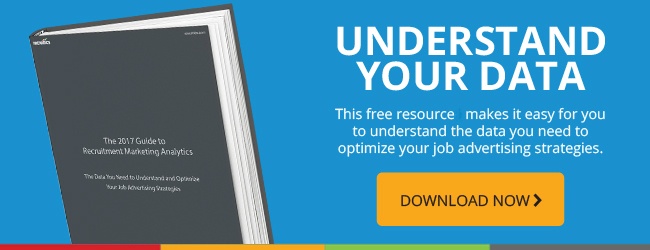Editor's Note: FREE Recruitics Analytics (beta) is now open! To learn more about our free recruitment marketing analytics dashboard and to sign up, click here.
Last year, the Society of Human Resources Management (SHRM) reported that two-thirds of companies that participated in their annual survey said that they’re having a more difficult time hiring now than in the past.
And in 2017, that trend is continuing with 40 percent of global employers reporting talent shortages--the largest such reporting since 2006.
As talent acquisition continues to be increasingly difficult and complicated, recruitment marketing analytics are no longer a “nice-to-have” but rather the critical resource of any successful hiring strategy.
Recruitment marketing analytics allow you to make data-driven decisions with your job advertising strategies, which will in turn help you differentiate yourself amongst the competition in this talent-driven marketplace.
In order to illustrate the true value of having access to detailed recruitment marketing analytics, let’s look at two common questions you’ve probably already asked yourself, and how recruitment marketing analytics can help you answer them:
What is the best source to advertise this particular type of job on?
We’ve all been there before: There’s one job that needs to be advertised, but you’ve been given a limited budget to do so. While some might “post and pray,” the data-driven recruitment marketer asks themselves, “where can I get the most bang for my buck?” The answer you’re really looking for is, on which of the many sources in my diversified strategy will this job perform best--or which will produce the greatest ROI.
Having deep recruitment marketing analytics should give you access to job-level data for every source you’re using, which will help you estimate how your job will perform by source, based on the analysis of data from similar jobs you’ve posted in the past on the same sources. This will help you save time and money because any job posted on a poorly performing source only creates waste in both respects.
What is the best type of job to advertise on this particular source?
On the flip side of job-level data is source-level data. In this case, it’s likely that you’re already spending money advertising jobs on a number of vendors, but you want to understand which jobs perform best on each. A detailed source report from a recruitment marketing analytics dashboard can help you break down the performance of each source in a number of different ways.
For instance, analytics like this can help you understand how jobs perform on a given source based on attributes such as the location of the job, the department it belongs to, the type of job, or even the industry. Source reports can, for instance, show you that only engineering jobs in New York City perform well on Source A, while IT jobs in Chicago struggle to get applicants from that same source. At the end of the day, having access to deeper recruitment marketing analytics like these help you answer important questions that will allow you to optimize the performance of each source by only advertising the jobs where they’ll have greater success.
As the skills gap persists, the contingency workforce grows and the unemployment rate continues to shrink, attracting, engaging and hiring full-time talent is only expected to get even more difficult.
The best way to combat a talent-driven marketplace that’s increasingly difficult to navigate is to understand your recruitment marketing efforts better than the competition and to optimize your strategy using that data. A recruitment marketing analytics dashboard that can unearth deep insights, then, is the key to success.
We’ll soon be launching a recruitment marketing analytics dashboard, Recruitics Analytics, that will help you answer these two common questions, and more, for FREE--but you can get early access now! To learn more about free Recruitics Analytics and to request your early access, click here.




